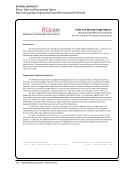SPEC Kit 329: Managing Born-Digital Special Collections and Archival Materials · 21
Survey Questions and Responses
The SPEC survey on Managing Born-digital Special Collections and Archival Materials was designed by
Naomi Nelson, Director of the David M. Rubenstein Rare Book &Manuscript Library, and Seth Shaw,
Electronic Records Archivist, at Duke University Cynthia Ghering, director of the University Archives
and Historical Collections, and Lisa Schmidt, Electronic Records Archivist, at Michigan State University
Michelle Belden, Access Archivist and IT Coordinator for the Special Collections Library, Jackie R.
Esposito, University Archivist and Head, Records Management Services, and Tim Pyatt, Dorothy Foehr
Huck Chair and Head of the Eberly Family Special Collections Library, at Pennsylvania State University
and Nancy Deromedi, head of the Digital Curation division, and Michael Shallcross, Assistant Archivist,
in the Bentley Historical Library at the University of Michigan. These results are based on data submitted
by 64 of the 126 ARL member libraries (51%) by the deadline of March 26, 2012. The survey’s introductory
text and questions are reproduced below, followed by the response data and selected comments from the
respondents.
The 2010 OCLC Research report, Taking Our Pulse, listed management of born-digital materials as the biggest challenge facing
libraries, special collections, and archives, after space and facilities concerns. Over the last decade the materials acquired for our
libraries, archives, and manuscript collections were very likely created as digital objects that may or may not have analog surrogates.
If modern special collections and archives are to stay relevant and continue to provide access to unique and authentic records, ARL
libraries need to manage and preserve born-digital materials, which for the purposes of this survey include institutional records,
author’s drafts on floppy discs, digital photographs and moving images, and electronic theses and dissertations, among others. It
excludes commercial products such as e-journals.
This survey explores the tools, workflow, and policies special collections and archives staff use to process, manage, and provide
access to born-digital materials they collect. It also looks at which staff process and manage born-digital materials and how they
acquire the skills they need for these activities, and how libraries have responded to the challenges that managing born-digital
materials present.
Survey Questions and Responses
The SPEC survey on Managing Born-digital Special Collections and Archival Materials was designed by
Naomi Nelson, Director of the David M. Rubenstein Rare Book &Manuscript Library, and Seth Shaw,
Electronic Records Archivist, at Duke University Cynthia Ghering, director of the University Archives
and Historical Collections, and Lisa Schmidt, Electronic Records Archivist, at Michigan State University
Michelle Belden, Access Archivist and IT Coordinator for the Special Collections Library, Jackie R.
Esposito, University Archivist and Head, Records Management Services, and Tim Pyatt, Dorothy Foehr
Huck Chair and Head of the Eberly Family Special Collections Library, at Pennsylvania State University
and Nancy Deromedi, head of the Digital Curation division, and Michael Shallcross, Assistant Archivist,
in the Bentley Historical Library at the University of Michigan. These results are based on data submitted
by 64 of the 126 ARL member libraries (51%) by the deadline of March 26, 2012. The survey’s introductory
text and questions are reproduced below, followed by the response data and selected comments from the
respondents.
The 2010 OCLC Research report, Taking Our Pulse, listed management of born-digital materials as the biggest challenge facing
libraries, special collections, and archives, after space and facilities concerns. Over the last decade the materials acquired for our
libraries, archives, and manuscript collections were very likely created as digital objects that may or may not have analog surrogates.
If modern special collections and archives are to stay relevant and continue to provide access to unique and authentic records, ARL
libraries need to manage and preserve born-digital materials, which for the purposes of this survey include institutional records,
author’s drafts on floppy discs, digital photographs and moving images, and electronic theses and dissertations, among others. It
excludes commercial products such as e-journals.
This survey explores the tools, workflow, and policies special collections and archives staff use to process, manage, and provide
access to born-digital materials they collect. It also looks at which staff process and manage born-digital materials and how they
acquire the skills they need for these activities, and how libraries have responded to the challenges that managing born-digital
materials present.










































































































































































































